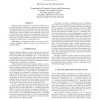954 search results - page 55 / 191 » Principles and Models for Organizing the IT Function |
CI
2004
13 years 7 months ago
2004
We consider automated decision aids that help users select the best solution from a large set of options. For such tools to successfully accomplish their task, eliciting and repre...
CSB
2003
IEEE
14 years 1 months ago
2003
IEEE
The complexity of the global organization and internal structures of motifs in higher eukaryotic organisms raises significant challenges for motif detection techniques. To achiev...
ML
2007
ACM
13 years 7 months ago
2007
ACM
Abstract Surrogate maximization (or minimization) (SM) algorithms are a family of algorithms that can be regarded as a generalization of expectation-maximization (EM) algorithms. A...
ICASSP
2009
IEEE
13 years 11 months ago
2009
IEEE
Monaural speech segregation in reverberant environments is a very difficult problem. We develop a supervised learning approach by proposing an objective function that directly rel...
HICSS
1994
IEEE
13 years 11 months ago
1994
IEEE
Meeting memory features are poorly integrated into current group support systems (GSS). This paper discusses how to introduce meeting memory functionality into a GSS. The paper fi...

